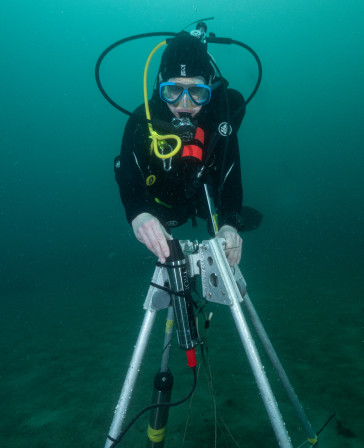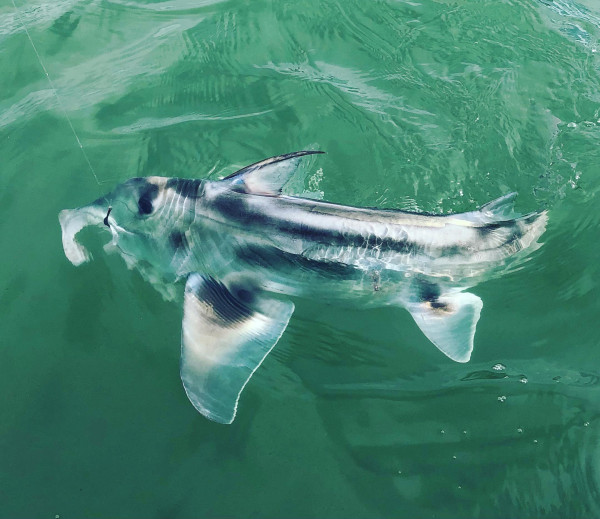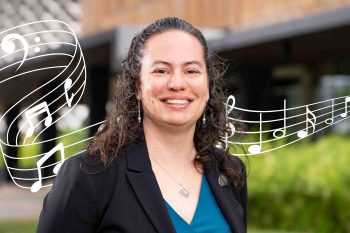© Pint of Science, 2025. All rights reserved.
The Science of Sound in the Sea
From early morning birdsong to the more annoying urban noises, humans are accustomed to sound on land. In the ocean, though, it’s a different story. Who is listening there, what are they hearing and how do they do so?
A scholar of the ocean
Dr Lucille Chapuis has always been fascinated by the ocean. Since learning to dive in the lakes of Switzerland, she has become ever more interested in the sounds (and species) of the world under water.
Reflecting on her diving experiences, Lucille describes an unexpected encounter with a humpback whale and its calf as unforgettable. In her words, ‘It was humbling and magical—one of those rare moments where you feel both tiny and incredibly connected to the ocean.’ Watching weedy sea dragons drift through seagrass beds, she says, is like ‘witnessing a living fairytale’.
While whales and sea dragons feature in fond memories, there is another species of particular interest, and that is sharks! Lucille reports that her favourite is the hammerhead, and, if she were to be a shark herself, she’d choose the mysterious lantern shark of the deep sea.
Today Lucille pursues her fascination with sharks as a research fellow at La Trobe University in Victoria. In technical terms, she is a marine bioacoustician and neuroecologist, which means she studies how animals hear and how brain structure and function is linked to the environment.
Fieldwork is an integral part of Lucille’s research, providing an opportunity to engage directly with the ecosystems and animals she’s studying. Her current project, ‘The ghost of oceans future’ seeks to understand how the Australian ghost shark is affected by increasing underwater noise pollution.
Encounters with ghost sharks themselves are rare and special, since these animals typically live in the deep sea. Most dives, then, are for ‘eavesdropping’ on their ocean home. More scientifically, this means deploying equipment like hydrophones (think a microphone that works underwater) which allow researchers to record and monitor soundscapes over long periods of time.

Dr Lucille Chapuis deploying a hydrophone to record the ocean soundscape. Photo Paul Caiger, courtesy Dr Lucille Chapuis.
Back on land, Lucille works to piece together the animal experience through a diverse array of research techniques. These range from studying cells under the microscope to conducting hearing tests on sleeping sharks! Other insights come from CT scans used to generate detailed three-dimensional images that can then be digitally dissected. Each technique offers insight into a fascinating sensory system.
The hearing system of sharks
Human hearing relies on sound waves travelling through air. Our outer ear, the pinna, captures them, the middle ear amplifies them, and the inner ear converts them to electrical signals for our brains to interpret. A rather different process enables sharks to engage with this sensory input.

A ghostshark—no ears in sight! Photo Travis Dutka, courtesy Dr Lucille Chapuis
In the ocean, sound waves must travel through a medium very different to air—but this happens to be a help rather than a hindrance. Sound waves move faster and further in water than they do in air, so it makes sense that sea creatures like sharks have evolved to rely on this sensory cue for navigation, communication and more.
Sharks host a remarkable array of sensory abilities, but their hearing has been something of a scientific mystery. Indeed, so little was known about it that Lucille dedicated her PhD to the acoustic world of sharks.
We now know that, while sharks do have ears (like all vertebrates), the structure and function of those ears is unique. Only a small pore links a shark’ inner ear to the outside world, so they ‘capture’ sound waves from the environment around them through their body as a whole. Inside the inner ear, dense crystals don’t respond to these waves in the same way as surrounding body tissues (which are largely made up of water like the ocean outside). This discrepancy causes hair cells in the inner ear to bend and signals to be sent to the brain for interpretation. Of all the sounds in the sea, is it food, a friend or perhaps a threat out there?
The sounds of the sea
There are three main types of sound in the sea. Biophony refers to sounds from animals, including whale song, fish calls and perhaps even rare stingray clicks! Geophony refers to natural sounds that don’t come from animals but from the environment, by way of waves, bubbles and raindrops on the water surface. Finally, anthrophony refers to sounds generated by human activity, such as shipping and construction noise.
In an era often referred to as the anthropocene, it is the level of anthrophony that has changed significantly in recent years, greatly increasing as shipping, seismic surveys and offshore construction become ever more prevalent. Biophony, on the other hand, is in decline as species numbers are depleted.
Lucille and her colleagues around the world are undertaking research to understand how species like the ghostshark are responding and adapting to a changing ocean soundscape. Others are investigating mitigation strategies like ‘bubble curtains’ that can interrupt the movement of sound waves generated by construction activity. There’s also the possibility that kelp forests could help, absorbing noise from passing boats and so providing a natural sound barrier.
Sound like you want to learn more?
Hear more about the science of ocean sounds (there’ll be sharks and seals too) during our annual festival, being held from 19 to 21 May 2025. Dr Lucille Chapuis will present ‘Shhh... Sharks are listening!’ at Carlton Brewhouse in Melbourne on Wednesday 21 May 2025.
Find out more about this year's events and book tickets on our festival page.
In the meantime, tune into a fascinating interview with Dr Chapuis on the World of Sharks podcast!
References
Bohne, T. and Rolfes, R. (2025). Investigating the influence of a bubble curtain on the underwater sound wave field generated by offshore pile driving. The Journal of the Acoustical Society of America, 157(1), pp.471–481. doi: https://doi.org/10.1121/10.0034841.
Chapuis, L. (2017). The Acoustic World of Sharks. [PhD] Available at: https://api.research-repository.uwa.edu.au/ws/portalfiles/portal/14770492/THESIS_DOCTOR_OF_PHILOSOPHY_CHAPUIS_Lucille_2017.pdf.
Discovery of Sound in the Sea (2017). Science of Sound. [online] Discovery of Sound in the Sea. Available at: https://dosits.org/science/ [Accessed 22 Apr. 2025].
Duarte, C. M., Chapuis, L., Collin, S. P., Costa, D. P., Devassy, R. P., Eguiluz, V. M., Erbe, C., Gordon, T. A. C., Halpern, B. S., Harding, H. R., Havlik, M. N., Meekan, M., Merchant, N. D., Miksis-Olds, J. L., Parsons, M., Predragovic, M., Radford, A. N., Radford, C. A., Simpson, S. D., … Juanes, F. (2021). The soundscape of the Anthropocene ocean. Science, 371(6529), eaba4658. https://doi.org/10.1126/science.aba4658
Lucille Chapuis. (2022). Save Our Seas Foundation. https://saveourseas.com/project-leader/lucille-chapuis/
Pijanowski, B.C., Farina, A., Gage, S.H., Dumyahn, S.L. and Krause, B.L. (2011). What is soundscape ecology? An introduction and overview of an emerging new science. Landscape Ecology, [online] 26(9), pp.1213–1232. https://doi.org/10.1007/s10980-011-9600-8.
Sueur, J., Krause, B. and Farina, A. (2019). Climate Change Is Breaking Earth’s Beat. Trends in Ecology & Evolution, [online] 34(11), pp.971–973. https://doi.org/10.1016/j.tree.2019.07.014.
Vila Pouca, C. and Brown, C. (2018). Food approach conditioning and discrimination learning using sound cues in benthic sharks. Animal Cognition, 21(4), pp.481–492. doi: https://doi.org/10.1007/s10071-018-1183-1.




